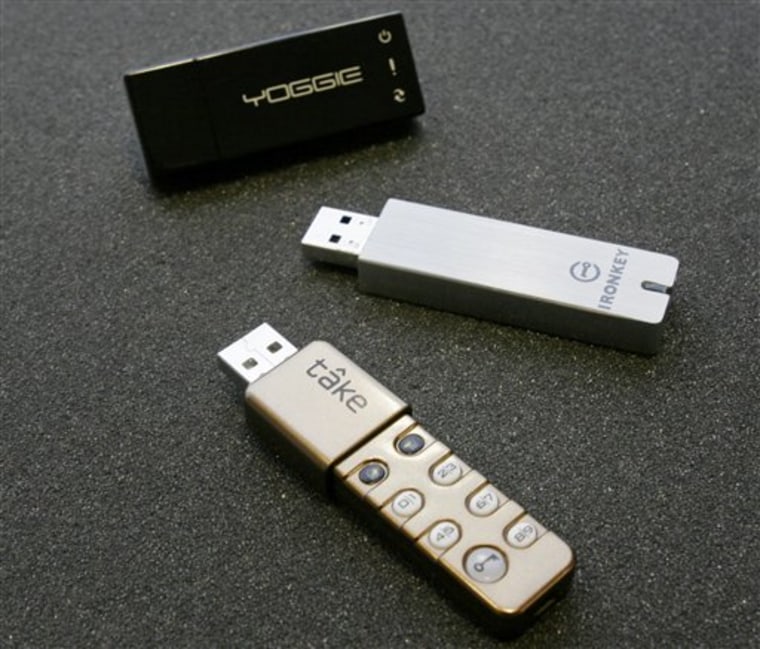Flash memory drives, the size of your thumb, are dirt cheap and offer gigabytes of storage. It's tempting to fill one of them with important computer files, clip it to a key chain and hit the road.
But what if you lose it while fumbling for change at Starbucks and the hacker in the corner finds it? This is not a good thing.
That's where a new breed of flash drives comes in — chock full of military-strength encryption and passwords and keypad combinations that must be entered before the data can be accessed.
I put a few secure flash drive solutions to the test: Take Anywhere's Pocket Safe ($59.95), the IronKey ($149) and TrueCrypt, a free software program that works with any USB flash drive.
Each had its strengths and limitations, but I liked the IronKey unit best, with its built-in Firefox browser, large storage space and powerful password protections.
Setting up my 4-gigabyte, brushed-metal IronKey drive was pretty painless. After putting it in a USB slot on my home PC, I was asked to create a user name and password before I could access any of the storage space or other features. (Among those extra features: You can create an encrypted backup of the IronKey's contents on a PC desktop.)
Then, every time you plug the IronKey into a computer, a control panel appears on the screen to ask for the password again. No password, no reading or tinkering with the drive's contents. In fact, you have to be careful, because if you enter the wrong password 10 times in a row the unit permanently deletes all of your data and is no longer usable. You can't even reformat it. That's tough love.
My favorite IronKey feature was the built-in Firefox browser. It let me take my favorite Web bookmarks and login information with me, along with my Web surfing cookies and site history. This means I left no trace of my Web browsing on the computers I plugged the IronKey into.
The IronKey works best with Windows XP, Linux and Mac OS X, according to the company.
Next up was the Pocket Safe (for Windows only), from Take Anywhere. The 1-gigabyte device sports a numerical keypad on its case. If you don't remember the password you create, you won't be able to launch the drive's software control panel.
I picked a four-digit password, but there are two numbers for each of the five entry buttons on the keypad. So if my access code were 1-2-3-4, someone could guess it by keying in 0-3-2-5 or 1-2-2-4 or other shared-button combinations. This was disappointing.
Once I keyed in my correct password, a green light began to blink, telling me it was safe to insert the Pocket Safe drive into my USB port.
The Pocket Safe's on-screen control panel features a column of icons down the left side, for categories of data such as financial accounts, Web site logins and vehicle records. This is handy for staying organized.
By default, Pocket Safe times out after 20 minutes of zero interactivity with the control panel, which got annoying. I had to go into the settings and beef it up to an hour.
TrueCrypt (for Windows 2000 and XP, Linux) is a piece of open-source software that promises to turn almost any USB flash drive into one Jason Bourne would be proud of. TrueCrypt creates and then hides a password-protected partition on the drive.
I installed the TrueCrypt application on my laptop and plugged in an old 512-megabyte flash drive, a giveaway from a tech convention. TrueCrypt let me choose between creating a file container on a portion of my flash drive (recommended for newbies) or encrypting the entire drive. Both methods worked flawlessly.
As a test, I plugged my TrueCrypt-encrypted flash drive into a PC that did not have the TrueCrypt application installed. I found the flash drive listed under "My Computer," but the PC recognized zero bytes of used space, and zero bytes of free space. Only installing TrueCrypt and knowing my password would uncloak my data. The method seems secure.
Beyond these three storage techniques, I also tried something else for people who want plug-in computer security: the $149 Yoggie Gatekeeper Pico. This unit looks like a flash drive but instead serves as a physical barrier of security for the laptop or desktop it's plugged into. Instead of relying on installed firewall security on your PC, the Yoggie asks that you uninstall your security software and let the flash drive itself do the protecting.
Once the Yoggie management software was installed and launched on my PC, I couldn't conduct any online activity unless the Yoggie was plugged in to the USB port. The makers of Yoggie say it's better to block Internet virus and malware threats before they reach your physical PC, rather than depending on installed software to root them out once they've arrived.
It generally worked, although the Yoggie software was sluggish and the unit wasn't always recognized by my PC. Sometimes the little blue lights on the Yoggie device blinked happily and let me proceed online, sometimes they didn't. Even when it was working, the Yoggie took too long to be recognized by its own software companion.
